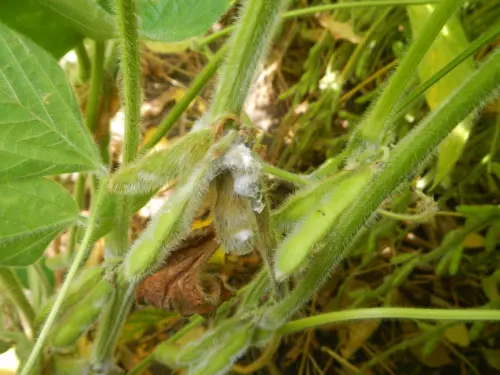Managing White Mold in Soybeans
Scientists call white mold in soyabeans as Sclerotinia sclerotiorum, and it is a huge problem for soybean farmers all over the world.

For white mold in soybeans treatment, Trianum Shield is the best fungicide for white mold. It is paired with Trichoderma Harzianum, which can help reduce the fungal growth and increase plant immunity. This fosters healthier plants and improves soil health without resistance issues.
Fungus disease reduces yield and impacts soybean quality, necessitating awareness among farmers and agricultural workers about white mold signs. Effective management techniques are crucial. This blog aims to explain white mold on soybeans, its signs, and best practices for combating the widespread disease.
How to Understand White Mold in Soybeans
Because white mold grows best in cool, damp places, soybean fields with thick canopies and lots of humidity are great places for it to grow. As sclerotia, the fungus starts its life cycle. These can stay in the soil for years, waiting for the right conditions to attack plants. When the conditions are right, which usually happens when soybeans are blooming, the sclerotia germinate and grow into mushroom-like structures that release spores. These germs get into the soybean plants and cause the disease to grow.

Signs of White Mold
- Plants That Wilt: To begin with, soybean plants that have white mold may start to wilt, starting with the top leaves. People often mistake this drooping for water stress because it looks like the plants aren’t getting enough water. But if you look more closely, you might see that the wilting continues even when the plant is properly watered, which could mean it has an infection.
- There is white, cottony mycelial growth: Seeing a white, cottony material on the stems and sometimes the branches of soybean plants is a clear sign of white mold. This stuff is the mycelial growth of the fungus Sclerotinia sclerotiorum. It’s most often seen at or near the surface of the dirt, which is a good place for fungi to grow. This mycelium can take over big parts of the stem, which causes more symptoms and the plant to die.

- Formation of Sclerotia: As the disease gets worse, sclerotia, which are hard, black structures, start to form inside the white, cottony mycelium. These sclerotia are the fungus’s main way of staying alive, letting it stay alive in bad circumstances. They are either on the outside of roots or deep inside the tissue. Sclerotia are a key sign of white mold. They can stay in the soil for years, which means that future crops could be at risk.
- Lower Yield and Quality: White mold has effects on the plant that can be seen, but it also lowers the yield and quality of the soybeans in a big way. Plants that are infected might make fewer pods, and the seeds inside might not be as good. The disease can also make harvesting harder because plants that are sick are less likely to grow well.
How do you control white mold in soybeans?
Here are easy ways for white mold soybeans treatment:
- Crop Rotation: Avoid planting soybeans in the same field successively to reduce soil-borne inoculum levels of the pathogen.
- Tillage Practices: Implementing no-till or reduced tillage can reduce the survival of the sclerotia in soil, thus lowering disease pressure.
- Planting Resistant Varieties: Select soybean varieties that have shown resistance or tolerance to white mold.
- Row Spacing and Planting Density: Wider row spacing and reduced planting densities can improve air circulation and reduce humidity within the crop canopy, making conditions less favorable for disease development.
- Irrigation Management: Avoid overhead irrigation during flowering to minimize moisture on plant surfaces, which can promote disease development.
- Field Hygiene: Removing or burying infected plant residues can reduce the source of inoculum for future crops.

- Biological Control with Trianum Shield and Trichoderma Harzianum: The fungicide for mold such as Trianum Shield, leveraging the active ingredient Trichoderma Harzianum, is beneficial in managing white mold on soybeans through its biological action. Trichoderma Harzianum inhibits pathogenic fungi growth, breaks down their cell walls, and stimulates plant immune systems. It controls disease spread and promotes healthier plant growth and soil conditions. This makes it a sustainable and eco-friendly option for soybean disease management.
Other Problems and Solutions for soybean, tomoto and cucumber :
- Treat soybean cyst nematode
- Controlling Root Knot Nematode on Tomato and Cucumber
- Managing Septoria Leaf Spot Tomato
References:
- Sumida, Ciro H., et al. “Trichoderma asperelloides antagonism to nine Sclerotinia sclerotiorum strains and biological control of white mold disease in soybean plants.” Biocontrol science and technology 28.2 (2018): 142-156.
- Juliatti, Fernando C., et al. “Trichoderma as a biocontrol agent against Sclerotinia stem rot or white mold on soybeans in Brazil: usage and technology.” Trichoderma-The Most Widely Used Fungicide 39 (2019).





Leave a Reply